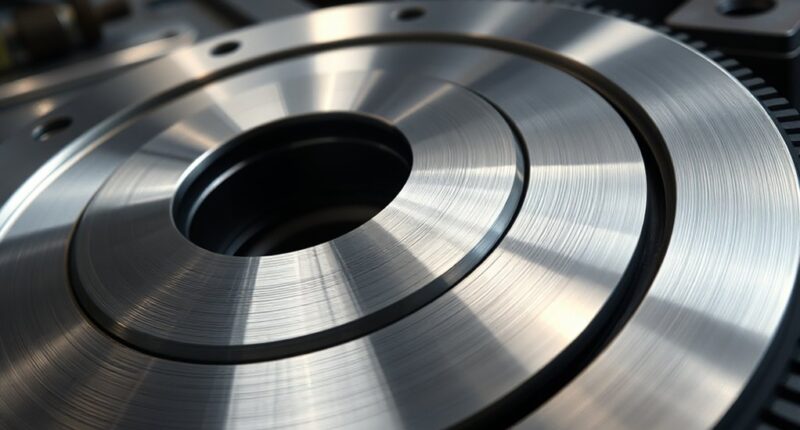A lightweight flywheel boosts your engine’s responsiveness and makes acceleration feel sharper, which is great for city driving and stop-and-go traffic. It gives you quicker throttle response and a more connected feel during gear changes. However, it can lead to increased wear on the clutch and may cause a twitchy, sensitive driving experience. If you’re curious about balancing performance with longevity, exploring the details further can help you decide if it’s right for you.
Key Takeaways
- Lightweight flywheels improve throttle response and engine responsiveness, enhancing daily driving agility.
- They may cause a slightly twitchy feel at low speeds, requiring driver adaptation.
- Proper maintenance and cooling are essential to prevent warping or damage during daily use.
- Increased responsiveness can lead to faster clutch wear, necessitating more frequent inspections.
- Overall, they offer a sportier driving experience without significant modifications, suitable for city and stop-and-go traffic.

Lightweight flywheels are transforming how engines handle power and efficiency. If you’re considering an upgrade or just want to understand how they affect your daily driver, it’s essential to grasp how they impact engine response and what maintenance tips you should keep in mind. A lightweight flywheel reduces mass, allowing your engine to rev more quickly and smoothly. This means when you press the accelerator, you’ll notice a more immediate response, giving your car a sportier feel. The lighter rotational mass makes the engine spin up faster, which can be a significant advantage in city driving or stop-and-go traffic. However, this increased responsiveness also means your engine’s behavior becomes more sensitive to driver inputs, requiring a bit of adaptation if you’re used to a heavier flywheel.
One of the key benefits of a lightweight flywheel is improved engine response. With less weight to turn over, your engine can accelerate and decelerate more quickly, making your vehicle feel more lively and agile. This is especially noticeable during gear changes, where the engine’s RPM adjusts swiftly, providing a more connected driving experience. For daily drivers, this can translate to a more enjoyable commute with quicker throttle response and less lag. Nevertheless, it’s worth considering that such responsiveness might sometimes make your car feel a little twitchy at lower speeds or during delicate maneuvers, so it’s something to get accustomed to over time.
When it comes to maintenance tips, lighter flywheels generally don’t require special care beyond standard procedures. Still, because they change how your engine responds, you should pay close attention to your clutch operation if your vehicle is manual. A lightweight flywheel can lead to increased wear on your clutch components because of the sharper engagement. Regular inspections and timely replacements of clutch parts will ensure smooth operation. Additionally, if you notice unusual vibrations or noises, it’s wise to have a mechanic check the flywheel for any signs of imbalance or damage. Since lightweight flywheels can sometimes be more prone to warping under extreme conditions, maintaining proper cooling and avoiding aggressive driving when the engine is cold can help prolong their lifespan. Furthermore, monitoring air quality indicators and ensuring your vehicle’s cooling system is functioning properly can help prevent overheating and potential warping of the lightweight component.
Frequently Asked Questions
How Do Lightweight Flywheels Affect Engine Longevity?
Using a lightweight flywheel can slightly increase engine wear over time because it reduces the inertia that helps smooth engine operation, leading to more abrupt engine responses. You might notice more startup strain as the engine works harder to accelerate a lighter flywheel. However, if you drive carefully and maintain your vehicle properly, these effects are usually minimal and shouldn’t substantially impact your engine’s overall longevity.
Are Lightweight Flywheels Suitable for All Vehicle Types?
You might find lightweight flywheels aren’t suitable for all vehicle types, especially if your driving style involves lots of stop-and-go traffic or heavy towing. While they improve throttle response, they can cause rough idling or less smoothness in some cars. Check your vehicle’s compatibility first, and consider your driving habits—if you’re not careful, you could end up biting off more than you can chew.
What Are the Best Materials Used in Lightweight Flywheels?
When choosing materials for lightweight flywheels, carbon composites and aluminum alloys stand out as top options. Carbon composites are incredibly strong yet lightweight, providing excellent durability and performance. Aluminum alloys also reduce weight effectively while maintaining good strength and heat resistance. You’ll benefit from quicker throttle response and smoother operation with these materials, making them ideal for daily drivers seeking improved efficiency without sacrificing reliability.
Can a Lightweight Flywheel Improve Fuel Efficiency?
A lightweight flywheel can improve your fuel efficiency by enhancing engine responsiveness, allowing your engine to rev more freely and reducing strain during acceleration. You’ll notice quicker throttle response and smoother idle stability, which helps optimize fuel consumption. However, keep in mind that the benefits depend on your driving style and vehicle setup. For daily drivers, a well-chosen lightweight flywheel can make your drive more efficient and enjoyable.
How Does Installation Complexity Compare to Standard Flywheels?
Imagine your engine’s rhythm speeding up as you install a lightweight flywheel. You’ll find it more complex than a standard one, needing careful clutch replacement and precise balancing calibration. Unlike standard flywheels, which slide in easily, the lightweight version demands extra attention to detail, making the process more labor-intensive. Your mechanic must guarantee everything’s perfectly aligned, so expect a slightly longer installation time but a rewarding upgrade in responsiveness.
Conclusion
Switching to a lightweight flywheel can boost your car’s responsiveness and acceleration, making every drive more exciting. Did you know that drivers report a 15% quicker throttle response after upgrading? While it can increase engine chatter and reduce smoothness at idle, the thrill of sharper performance often outweighs these downsides. If you crave a more agile, lively ride, embracing a lightweight flywheel might just be the upgrade you need to elevate your daily driving experience.









